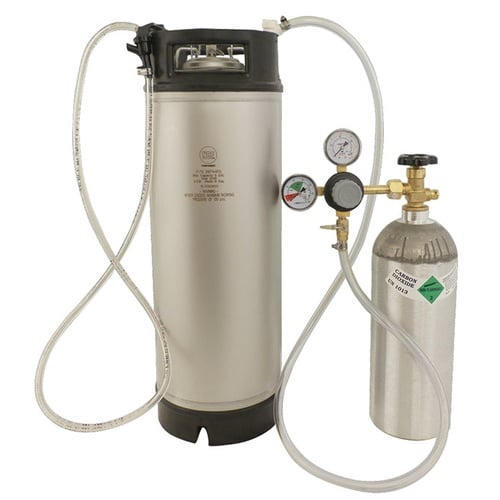
Today I take a look at some of the challenges you face when trying to keg still mead, wine or cider. Many beer brewers also make mead, wine and cider, and also have kegging equipment. Kegging your mead, wine and cider can be much easier than bottling. Also there is a substantial advantage to being able to pour just a glass or two of wine or mead rather than having to open an entire bottle.
Low Pressure Kegging for Still Beverages
Most beer brewers force carbonate their beer by applying CO2 pressure to the keg and storing the keg in a fridge. A combination of temperature, pressure and time will carbonate the beer.
A still beverage is served un-carbonated. For still beverages like most wines, and many meads and ciders, you don’t want any carbonation. A simple way to do this is to simply purge your keg with CO2 at a very low pressure.
So if you are kegging some red wine, for instance, you would siphon the wine from your fermenter into the keg, and then set your CO2 regulator to a low pressure – perhaps 2-3 psi (7 kpa). Seal the lid, apply pressure, and then release the purge valve several times to purge any remaining air out of the keg.
Once the keg is purged you can remove the gas source. I typically will just leave a picnic tap attached to the keg and serve from it. The small amount of pressure should be enough to serve your beverage, and you can apply more gas (again at low pressure) if the flow gets too slow.
Alternatives to CO2 for Kegging Wine
Even though the CO2 option above works well for many still beverages, carbon dioxide can still affect the balance of some beverages – particularly wines.
While all wines contain a slight amount of residual CO2 from fermentation, adding carbon dioxide to the wine creates some carbonic acid which can alter the flavor balance of wine over time. This can also affect some fine meads and ciders, though often the mead or cider’s other flavors will mask these effects.
As a result many commercial wine kegging systems go to great lengths to avoid changing the CO2 balance of the wine. There are several ways to do this: One is to use an inert gas like Argon or pure Nitrogen to pressurize the keg. Since Argon and Nitrogen are inert, it won’t affect the flavor balance of the wine.
Another method I’ve seen is to actually place the wine inside of mylar bags inside of the wine keg. Regular CO2 is used in the keg space outside of the bags, compressing the bag and forcing the wine out of the keg.
Another option is to use a CO2-nitrogen mix. In fact, some wine kegging systems use both a CO2 gas source and a nitrogen gas source and then have an adjustable mixer that controls the CO2 percentage in an attempt to match the native CO2 content of the wine. Depending on the style of wine and temperature it is served at you can adjust the mixer so it does not alter the balance of the wine.
For home brewers the two best options are Argon/Nitrogen or a CO2-Nitrogen mix. Argon and nitrogen are readily available from gas supply stores but can be quite expensive, and you will typically need a separate regulator. More commonly, home brewers use the typical “Stout mix” which is 25% CO2 and 75% nitrogen.
It turns out that the stout mix is very close to an average wine’s ideal mix for beverages around room temperature. As a result, using a stout mix on a typical wine at low pressure won’t change the CO2 flavor balance of the wine much. So a talk of “stout mix” is a good alternative for beer brewers who might also enjoy using that mix for serving stouts. I have personally stored wines in kegs for several years using a stout mix with great results.
Hopefully the information above will help you if you want to keg your still wine, mead or cider. Thanks for joining me on the BeerSmith Home Brewing Blog. Be sure to sign up for my newsletter or my podcast (also on itunes…and youtube) for more great tips on homebrewing.